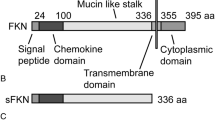Abstract
Chemokines and their receptors have been strongly implicated in the inflammatory process and pathogenesis of the neurodegenerative disorders, such as Alzheimer’s disease (AD). In the present study, we examined the expression of chemokines, fractalkine, interferon-inducible protein-10 (IP-10) and macrophage inflammatory protein-1α (MIP-1α) by immunohistochemistry in the brain of transgenic mice APPSWE (Tg2576) at ages of 9, 11, and 17 months, which over-express a mutated form of human amyloid precursor protein (APP). Decreased fractalkine and increased IP-10 expression in cerebral cortex and hippocampus were found at ages of 9 and 17 months in Tg2576 mice when compared with age-matched control mice. On the contrary, MIP-1α expression showed no difference between Tg2576 mice and aged controls and was not influenced by ages. β-amyloid (Aβ) positive plaques were co-located with the intense IP-10 expression. The finding suggests fractalkine and IP-10 may participate in the pathogenesis of AD; and could be new therapeutic strategies for neuroprotection.





Similar content being viewed by others
References
Akiyama H, Barger S, Barnum S et al (2000) Inflammation and Alzheimer’s disease. Neurobiol Aging 21:383–421
Johnstone M, Gearing AJ, Miller KM (1999) A central role for astrocytes in the inflammatory response to beta-amyloid; chemokines, cytokines and reactive oxygen species are produced. J Neuroimmunol 93:182–193
Xia MQ, Bacskai BJ, Knowles RB et al (2000) Expression of the chemokine receptor CXCR3 on neurons and the elevated expression of its ligand IP-10 in reactive astrocytes: in vitro ERK1/2 activation and role in Alzheimer’s disease. J Neuroimmunol 108:227–235
Smits HA, Rijsmus A, van Loon JH et al (2002) Amyloid-beta-induced chemokine production in primary human macrophages and astrocytes. J Neuroimmunol 127:160–168
Hsiao K, Chapman P, Nilsen S et al (1996) Correlative memory deficits, Abeta elevation, and amyloid plaques in transgenic mice. Science 274:99–102
Frautschy SA, Yang F, Irrizarry M et al (1998) Microglial response to amyloid plaques in APPsw transgenic mice. Am J Pathol 152:307–317
Irizarry MC, McNamara M, Fedorchak K et al (1997) APPSw transgenic mice develop age-related A beta deposits and neuropil abnormalities, but no neuronal loss in CA1. J Neuropathol Exp Neurol 56:965–973
Harrison JK, Jiang Y, Chen S et al (1998) Role for neuronally derived fractalkine in mediating interactions between neurons and CX3CR1-expressing microglia. Proc Natl Acad Sci USA 95:10896–108901
Re DB, Przedborski S (2006) Fractalkine: moving from chemotaxis to neuroprotection. Nat Neurosci 9:859–861
Mizuno T, Kawanokuchi J, Numata K et al (2003) Production and neuroprotective functions of fractalkine in the central nervous system. Brain Res 979:65–70
Cardona AE, Pioro EP, Sasse ME et al (2006) Control of microglial neurotoxicity by the fractalkine receptor. Nat Neurosci 9:917–924
Bajetto A, Bonavia R, Barbero S et al (2001) Chemokines and their receptors in the central nervous system. Front Neuroendocrinol 22:147–184
Cartier L, Hartley O, Dubois-Dauphin M et al (2005) Chemokine receptors in the central nervous system: role in brain inflammation and neurodegenerative diseases. Brain Res Brain Res Rev 48:16–42
Goldberg SH, van der Meer P, Hesselgesser J et al (2001) CXCR3 expression in human central nervous system diseases. Neuropathol Appl Neurobiol 27:127–138
Wang X, Ellison JA, Siren AL et al (1998) Prolonged expression of interferon-inducible protein-10 in ischemic cortex after permanent occlusion of the middle cerebral artery in rat. J Neurochem 71:1194–1204
Masliah E, Sisk A, Mallory M et al (1996) Comparison of neurodegenerative pathology in transgenic mice overexpressing V717F beta-amyloid precursor protein and Alzheimer’s disease. J Neurosci 16:5795–5811
Stalder M, Phinney A, Probst A et al (1999) Association of microglia with amyloid plaques in brains of APP23 transgenic mice. Am J Pathol 154:1673–1684
Mandybur TI, Chuirazzi CC (1990) Astrocytes and the plaques of Alzheimer’s disease. Neurology 40:635–639
Acknowledgments
This study was supported by grants from SADF (Insamlingsstiftelsen för Alzheimer- och Demensforskning) foundation, Gun och Bertil Stohnes foundation and funds from gamla tjänarinnor foundation. The authors are very grateful to Dr. K. Hsiao (Department of Neurology, University of Minnesota, Minneapolis, USA) for providing the brains of the transgenic mouse model of Alzheimer’s disease used here.
Author information
Authors and Affiliations
Corresponding author
Rights and permissions
About this article
Cite this article
Duan, RS., Yang, X., Chen, ZG. et al. Decreased Fractalkine and Increased IP-10 Expression in Aged Brain of APPswe Transgenic Mice. Neurochem Res 33, 1085–1089 (2008). https://doi.org/10.1007/s11064-007-9554-z
Received:
Accepted:
Published:
Issue Date:
DOI: https://doi.org/10.1007/s11064-007-9554-z




